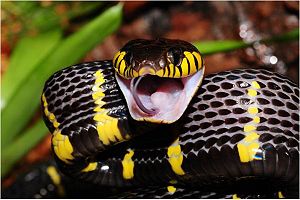Sandbox Reserved 932
From Proteopedia
m |
|||
| Line 50: | Line 50: | ||
There are no significant differences in the sequence of functionally important loops A-F of nAChR in mice and chicks. However in the prior region of loop F, chicks have several changes in their amino acid composition leading to introduction of positive charge in the front of the functionally active loop F. This might have important functionality in the attraction and binding of denmotoxin specifically to bird nAChRs. | There are no significant differences in the sequence of functionally important loops A-F of nAChR in mice and chicks. However in the prior region of loop F, chicks have several changes in their amino acid composition leading to introduction of positive charge in the front of the functionally active loop F. This might have important functionality in the attraction and binding of denmotoxin specifically to bird nAChRs. | ||
| - | Snakes and some other terrestrial animals such as mongoose have achieved resistance to denmotoxin by introducing a mutation to asparagine (e.g. W→N) in one of the aromatic AChR binding residues (see fig.). This allows introduction of N-glycolysation inside the binding pocket leading to spatial inhibition of denmotoxin binding, but still allowing the natural ligand ACh to interact with the receptor. | ||
===Conclusions=== | ===Conclusions=== | ||
Revision as of 16:25, 17 May 2014
| This Sandbox is Reserved from 01/04/2014, through 30/06/2014 for use in the course "510042. Protein structure, function and folding" taught by Prof Adrian Goldman, Tommi Kajander, Taru Meri, Konstantin Kogan and Juho Kellosalo at the University of Helsinki. This reservation includes Sandbox Reserved 923 through Sandbox Reserved 947. |
To get started:
More help: Help:Editing |
B. Dendrophila monomeric toxin (Denmotoxin) is the primary protein of snake venom used by Boiga dendrophila. This colubrid snake lives in Southest Asian lowland rainforest and mangrove swamps using birds as its primary prey.
One of the most well characterized snake venom protein families is the Three-finger-toxins (3FTX). These proteins consist of three β-stranded finger-like polypeptide loops stabilized by four disulphide bridges on the surface of a globular core. In non-convential 3TFXs a fifth disulphide bridge can be present as is the case in Denmotoxin. The crystal structure of denmotoxin was solved to 1.9Å by molecular replacement method.
Denmotoxin binds specifically to bird muscle nicotinic acetylcholine receptors preventing their normal function in signal transduction. This taxon specifity is reached by unique structural differences to other 3FTXs such as changes in the suggested binding loop of the protein.
Denmotoxin
| |||||||||||
Additional Information
References
Pawlak, J.; Mackessy, S.; Fry, B.; Bhatia, M.; Mourier, G.; Fruchart-Gaillard, C.; Servent, D.; Ménez, R.; Stura, E.; Ménez, A. 2006. Denmotoxin, a Three-finger Toxin from the Colubrid Snake Boiga dendrophila (Mangrove Catsnake) with Bird-specific Activity. The Journal of Biological Chemistry: 281: 29030-29041 doi: 10.1074/jbc.M605850200

![Three fingers formed by three peptide loops (F1, F2 & F3) [PDB=2H5F]](/wiki/images/thumb/3/3f/Kolme_sormea_figure_text.png/300px-Kolme_sormea_figure_text.png)
![Suggested interaction of α-bungarotoxin in binding pocket of nAChR (simplified figure) [PDB=4HQP]](/wiki/images/thumb/d/d7/Bungarotoxin_interaction_with_nACHr_figure_text.png/300px-Bungarotoxin_interaction_with_nACHr_figure_text.png)
